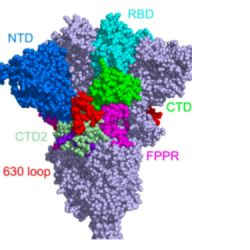You may have encountered the term "D614G mutation" when reading about the COVID delta variant. What does this mean? Why is it important? Why does it make "delta COVID" more infectious? Keep reading.
It's a bit of an oversimplification, but not by much. One molecule of "vinegar" is responsible for a whole lot of disease and deaths all over the world. Before you make a mad dash to your kitchen cabinet to rid yourself of the deadly potion, you need to know a little chemistry. My apologies. But you know what's coming...

You have probably read (and been confused by) news stories saying that the delta variant has something called a D614G mutation. Let's translate this into English.

D614G means that amino acid #614 in a protein chain consisting of 1273 amino acids (!) has changed from D (the single-letter abbreviation for aspartic acid) in the original variant to G (glycine) in the delta variant. The difference between the two amino acids (above) is essentially one molecule of acetic acid (vinegar) (1). This seemingly trivial change is anything but; it profoundly affects the properties of the spike protein, which in turn makes the delta variant much more contagious. This change in one of the 1273 amino acids that make up the spike protein is literally the difference between life and death. This is a quintessential example of how biology, no matter how complex, is governed by fundamental chemistry.
Why is Aspartic Acid Replaced By Glycine?
Blame the genetic code. It tells us that different combinations of three consecutive nucleobases called codons determine which of the 20 amino acids is synthesized, and therefore which proteins are made by the RNA. Figure 1 shows the four nucleobases found in RNA (2). To minimize the number of readers hurling themselves out of windows, I'll try to keep this as simple as possible. 
Figure 1. (Left) A strand of RNA showing all four nucleobases. (Right) The codons responsible for the synthesis of aspartic acid (left) and glycine (right). Source: Byjus.com
Aspartic acid (abbreviation D) is made by codons guanine-adenine-uracil (GAU) or guanine-adenine-cytosine (GAC). Glycine (abbreviation G) is made by codons guanine-guanine-uracil (GGU) or guanine-guanine-cytidine (GGC). Note that the two differ only by the middle nucleobase (red boxes) in the grouping of three. In both cases, adenine (A) has been replaced by guanine (G). No big deal, right? Yet, this single base mutation is sufficient to program the virus to change amino acid #614 from aspartic acid (D) to glycine (G) and give the world the lovely gift of D614G; hence, delta COVID.
How Did the "Wrong" Nucleobase Get Stuck Into the Original RNA?
Normally, nucleobases are incorporated into the growing RNA chain of the progeny virus in the same order in which they appear in the RNA of the original virus. But viruses are very "clever." Frequently they make an "intentional error" (especially RNA viruses), resulting in the wrong nucleobase being incorporated into a codon. This error is called a mutation, and it is how viruses survive and thrive. Mutations are the driving force behind infectivity and virulence in an extraordinary example of evolution in its most basic form.
How Did Glycine Come to Replace Aspartic Acid in the Delta Variant?
RNA viruses mutate like crazy – at rates that are millions of times that of their host cells. Most mutations are dead ends, but some will result in an "improved" virus with properties that give it an advantage over its "parent," for example, higher infectivity, resistance to drugs, or a difference in virulence. This is exactly what happened with "delta COVID." It replaced "old COVID" because it is significantly more infectious. This is a fine example of natural selection at the atomic level.
It All Boils Down to Chemistry
As I discussed above, the D614G mutation responsible for the delta variant is caused by a guanine molecule being incorporated in the growing RNA chain instead of adenine. Take a look at the chemical structures of the two, and you can see why this is an "easy error." Structurally, adenine and guanine look very much alike. If you take adenine, move the amino group (green circles) to a different position and replace it with an oxygen atom; voila, that's it.

Also, look at the chemical formulas of each. They differ by one lousy oxygen atom. But this seemingly insignificant change is sufficient to make a different virus that is now running rampant all over the world. One oxygen atom in a huge protein does all of this? If there is a better example of the impact of chemistry on biology and medicine, I haven't seen it.
Get Out Your Magnifying Glasses
Figure 2 shows the structures of the spike proteins of the original virus (left) and the delta variant (right). Can you see a difference? Good luck. If you can't, it's because of what I discussed earlier – aspartic acid #614 (of 1273) being replaced by glycine. The two amino acids differ by "a molecule of vinegar" (acetic acid), and the result is a modified virus that is killing thousands of people worldwide. How crazy is this??

Figure 2. The structures of the spike protein before (left) and after (right) the D614G mutation. Credit: Bing Chen, PhD, Boston Children's Hospital, CTV News
Why Does the D614G Mutation Make the Delta Variant More Infectious?
There is a reason for this, and it's fascinating, But let's leave that for another time. It's beyond the scope of this article, and those of you who are not already comatose have probably had enough.
NOTES:
(1) No, the difference between glycine and aspartic acid isn't precisely one molecule of acetic acid. It's acetic acid plus one hydrogen atom. Deal with it.
(2) DNA works in much the same way as RNA but has thymine in place of uracil.
(3) It is unfortunate that the nucleobase guanine and the amino acid glycine are both abbreviated G. Like this stuff isn't confusing enough?

